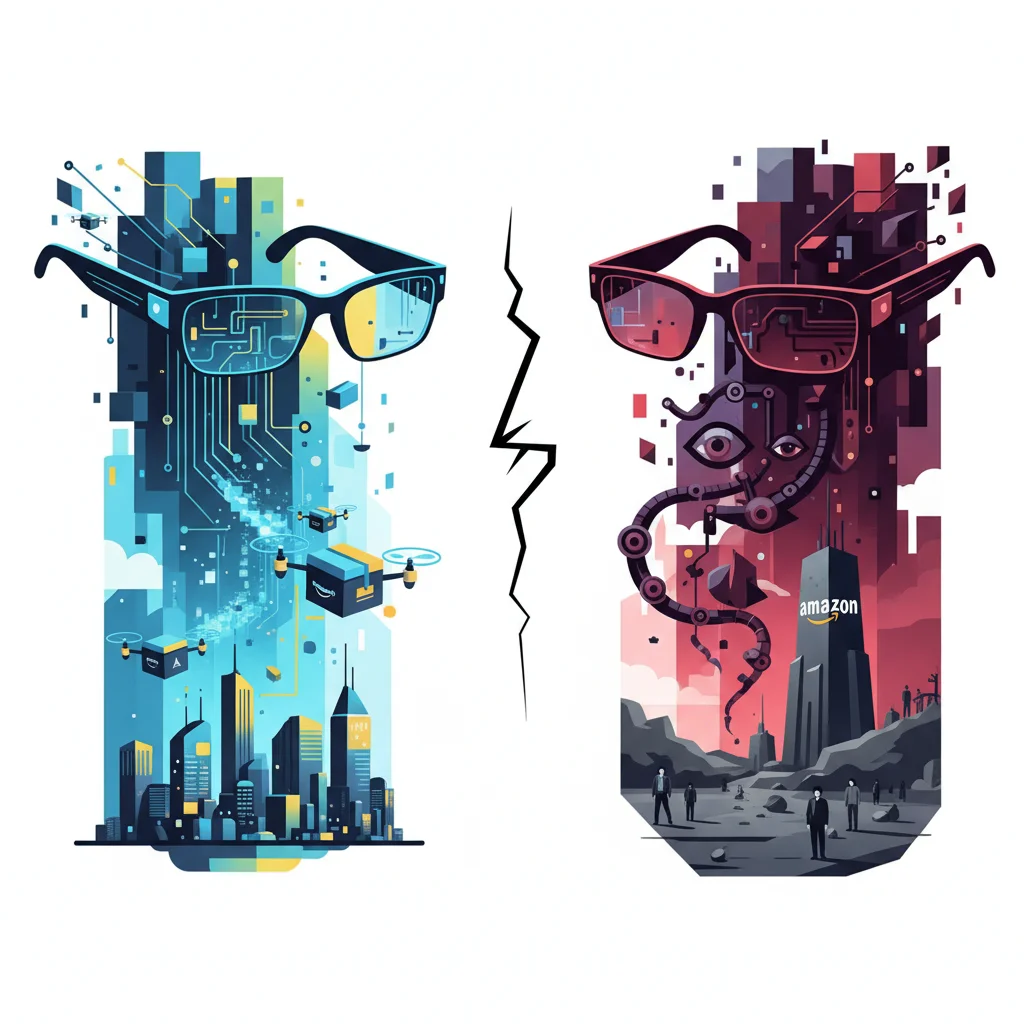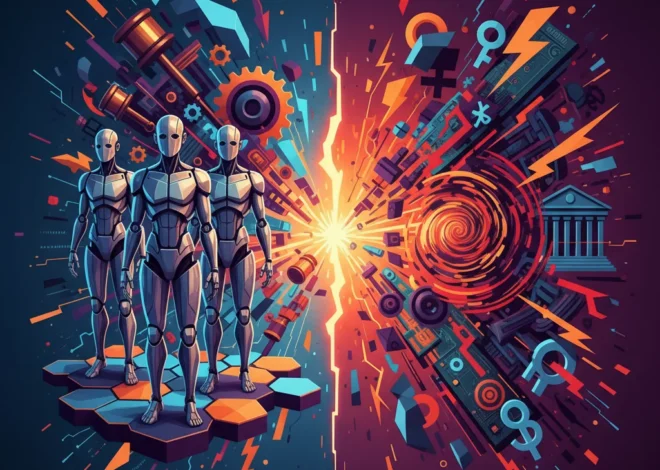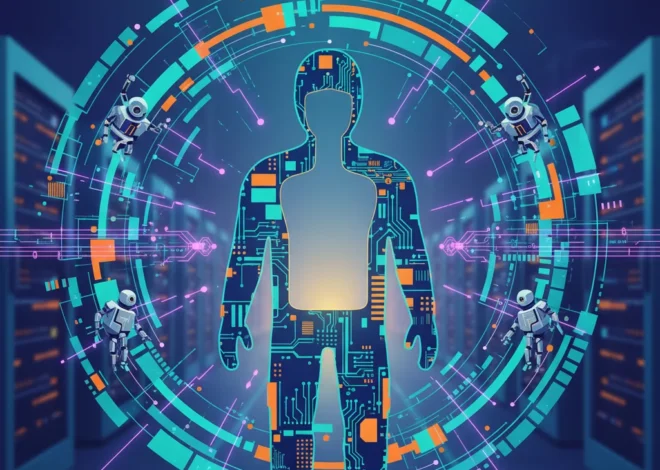
Amazon’s AI Glasses: A Delivery Revolution or a Dystopian Future?
In the relentless race for efficiency, the final mile of delivery has always been the most complex and costly puzzle. Now, Amazon, a titan of logistics and technology, is testing a solution straight out of science fiction: prototype artificial intelligence (AI) smart glasses designed exclusively for its delivery drivers. While the idea of smart glasses might evoke memories of Google Glass’s consumer-facing stumble, Amazon’s approach is laser-focused on the enterprise, aiming to transform the daily grind of its massive delivery network. The tech giant has confirmed these glasses are a specialized tool for its workforce, not a product destined for the general public.
But this isn’t just about a new gadget. This move signals a profound shift in how human labor and AI can be integrated at the ground level. It’s a story about cutting-edge software, immense cloud computing power, and the drive for hyper-automation. For developers, entrepreneurs, and tech professionals, this experiment is a living case study in the future of work, enterprise AR, and the complex ethical questions that trail closely behind groundbreaking innovation. Let’s unpack what these AI glasses really mean, the technology powering them, and the monumental implications for the industry and society at large.
What Are These AI-Powered Smart Glasses?
Imagine a delivery driver approaching a street lined with identical-looking houses. Instead of fumbling with a smartphone, their glasses highlight the correct address, overlay a digital arrow pointing to the porch, and even scan the package in their hand to confirm it’s the right one. This is the promise of Amazon’s new device.
While Amazon has kept the exact specifications under wraps, we can infer the core functionalities based on the challenges of last-mile delivery. The system likely combines several key technologies:
- Augmented Reality (AR) Display: A heads-up display (HUD) that projects digital information onto the driver’s real-world view. This could include navigation prompts, delivery instructions, and package details.
- Computer Vision: Onboard cameras powered by sophisticated machine learning algorithms would constantly analyze the driver’s surroundings. This enables object recognition (identifying addresses, package labels, and potential hazards like pets or obstacles) and optical character recognition (OCR) for reading text.
- Voice Commands: A natural language processing (NLP) interface would allow drivers to interact with the system hands-free, confirming deliveries or asking for information with simple voice prompts.
- Seamless Connectivity: The glasses would be constantly connected to Amazon’s vast logistics network via the cloud, likely its own Amazon Web Services (AWS). This allows for real-time data synchronization, route updates, and performance tracking.
This isn’t Amazon’s first foray into wearable tech for its employees; they’ve used handheld scanners and other devices for years. However, integrating this functionality into a hands-free, vision-based interface represents a significant leap in cognitive automation, aiming to assist and augment the human worker in a far more intuitive way.
From Stun Guns to Smart Clouds: The AI-Powered Future of Taser Technology
The Technology Stack: More Than Just a Pair of Glasses
Creating a device like this is a monumental feat of engineering that goes far beyond the hardware. It’s a symphony of cutting-edge software, powerful backend infrastructure, and intricate programming.
At its core, this is a real-world application of edge computing combined with the immense power of the cloud. The glasses themselves will handle some processing locally (on the “edge”) for low-latency tasks like identifying a street sign. But the heavy lifting—like updating complex delivery routes based on real-time traffic data or running advanced machine learning models—will be offloaded to AWS servers. This distributed architecture is essentially a specialized SaaS (Software as a Service) platform for logistics.
The potential for efficiency gains is staggering. By shaving just a few seconds off each delivery step—from sorting in the van to confirming the drop-off—Amazon could save millions of hours in labor annually across its entire network. A company spokesperson might frame this as a tool to help drivers, but the underlying business driver is undeniable: radical optimization.
To illustrate the potential impact, let’s compare the traditional delivery workflow with an AI-assisted one.
| Delivery Task | Traditional Method | AI Glasses-Assisted Method | Potential Benefit |
|---|---|---|---|
| Package Sorting | Driver manually scans and organizes packages in the van. | Glasses highlight the next package needed and its location in the van. | Reduced sorting time, fewer errors. |
| Navigation | Glancing between the road and a mounted smartphone app. | AR arrows and instructions are overlaid directly on the driver’s view of the road. | Increased safety and focus. |
| Address Identification | Driver visually searches for house numbers, often in the dark or poor weather. | Computer vision highlights the correct address number instantly. | Faster stop times, reduced mis-deliveries. |
| Proof of Delivery | Driver uses a handheld device to take a photo. | Driver confirms with a voice command, and the glasses automatically capture a photo. | Hands-free operation, streamlined workflow. |
The Double-Edged Sword: Empowerment vs. Surveillance
The central tension of this technology is the classic trade-off between efficiency and privacy. For every potential benefit, there is a corresponding concern that must be addressed.
The Case for Empowerment:
From an optimistic viewpoint, these glasses could genuinely improve the driver’s experience. The job is notoriously stressful, involving tight schedules, unfamiliar routes, and pressure to perform. An AI assistant that streamlines the most tedious parts of the job could reduce cognitive load and stress. It could also drastically improve safety by providing real-time hazard warnings—flagging everything from an approaching car at a blind corner to an icy patch on a walkway. For new drivers, the glasses could serve as a real-time training tool, dramatically shortening the learning curve and boosting confidence.
The Case for Surveillance:
On the other hand, the potential for misuse is significant. The data collected could be used to enforce unrealistic productivity quotas, penalizing drivers for taking short breaks or for any deviation from an algorithmically-perfect route. This level of monitoring could create a high-pressure environment that leads to burnout and erodes trust. Furthermore, the cybersecurity implications are massive. A compromised system could not only disrupt deliveries but also expose sensitive customer data and even provide a live video feed from thousands of drivers, creating a privacy and security nightmare. Securing this network of mobile, interconnected devices is a challenge of epic proportions.
The Billion Handshake: Why Tech Giants Are Buying the Physical 'Warehouses' of the AI Revolution
Broader Implications for Startups and the Tech Industry
Amazon’s move, regardless of its ultimate success, sends ripples across the tech landscape. It validates the market for enterprise AR, a sector that has been slowly gaining traction in fields like manufacturing and healthcare.
For startups and developers, this opens up a new frontier. Opportunities will abound for:
- Specialized AI Software: Companies could develop niche machine learning models for specific logistics tasks (e.g., advanced pet detection, optimized indoor navigation for apartment complexes) that could be licensed as a service.
- Hardware Innovation: A renewed focus on enterprise AR will drive demand for more efficient processors, longer-lasting batteries, and more comfortable, durable hardware designs.
- Cybersecurity Solutions: Securing the Internet of Things (IoT) is already a massive industry. Securing a fleet of AI-powered wearables that are constantly moving and processing sensitive data presents a unique and lucrative challenge.
- Ethical Tech Frameworks: There will be a growing need for consulting and auditing services to help companies deploy such technologies responsibly, ensuring compliance with privacy regulations and maintaining employee trust.
This experiment could be the catalyst that finally pushes enterprise AR into the mainstream, much like the iPhone did for smartphones. The key difference from past failures like Google Glass is the targeted, problem-solving approach. Instead of being a solution in search of a problem, these glasses are designed to solve a very specific, very expensive problem: the inefficiency of the last mile. This focus is a crucial lesson for any entrepreneur working in the tech space.
Beyond the Zap: How AI and the Cloud are Transforming the Taser
The Road Ahead: A Glimpse into the Future of Work
Amazon’s AI smart glasses are more than just a new piece of hardware; they are a profound statement about the future of human-AI collaboration. As the project moves from prototype to potential deployment, it will force us to confront difficult questions about the balance between technological progress and human dignity in the workplace.
The success or failure of this initiative will not be measured solely by metrics of speed and efficiency. It will also be judged by its impact on the human beings wearing the technology. Will it be a tool that empowers them, making their difficult jobs easier and safer? Or will it become a symbol of an automated, panopticon-like future where every action is monitored and optimized to the millisecond?
The answer will shape not only the future of Amazon’s delivery network but will also serve as a blueprint—or a cautionary tale—for how artificial intelligence is integrated into every corner of our economy. The road ahead is being paved now, and it’s up to developers, business leaders, and policymakers to ensure it leads to a future that is not only more efficient but also more human.


